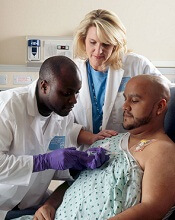
receiving chemotherapy
Photo by Rhoda Baer
Projections for 2016 suggest that leukemia deaths are on the decline in the European Union (EU), particularly for children and young adults.
Leukemia death rates are expected to fall 19% in men and 16% in women in 2016, when compared to 2007 data.
Rates are projected to fall 38% in boys and 20% in girls ages 0 to 14, 26% in men and 22% in women ages 15 to 44, and 19% in men and women ages 45 to 69.
Researchers said improvements in management, multidrug chemotherapy, immunotherapies, stem cell transplants, radiotherapy, and targeted therapies have all contributed to improvements in survival for leukemia patients.
However, some leukemias remain hard to treat, particularly those that are more common in adults and the elderly.
“Predictions of death rates from leukemia are complicated by the fact that leukemias are a varied collection of blood cancers, with some being more treatable than others,” said study author Carlo La Vecchia, MD, of the University of Milan in Italy.
“However, the important falls in overall death rates from this group of diseases are very encouraging and are a testament to the hard work of researchers and clinicians in developing and implementing better diagnosis and treatments.”
Dr Vecchia and his colleagues reported the results of this research in Annals of Oncology.
The researchers looked at cancer deaths in the EU as a whole and in the 6 largest countries—France, Germany, Italy, Poland, Spain, and the UK.
The team assessed mortality for all cancers and looked at individual data for cancers of the stomach, intestines, pancreas, lung, prostate, breast, and uterus (including cervix), as well as leukemias.
All cancers
The researchers’ projections suggest that total cancer mortality rates will decrease for both sexes in 2016, despite a rise in the absolute number of deaths due to the aging population. The team said the median age of the total EU population was 41 in 2011 and will be 42 in 2016.
So a total of 1,359,500 EU citizens are expected to die of cancer in 2016—753,600 men and 605,900 women. This is compared to 1,314,787 cancer deaths in 2011—734,259 men and 580,528 women.
The age-standardized mortality rates for 2016 are 133.5 per 100,000 men and 85.2 per 100,000 women, compared to 144.6 per 100,000 men and 88.1 per 100,000 women in 2011.
So that’s a 7.7% fall in cancer death rates for men and a 3.3% fall for women from 2011 through 2016, despite a 3.3% increase in the absolute number of cancer deaths.
Leukemias
The researchers predict that, in 2016, age-standardized leukemia mortality rates will be 3.95 per 100,000 men and 2.46 per 100,000 women.
In comparison, the age-standardized mortality rates for 2000-2004 were 5.23 for men and 3.20 for women. The rates for 2005-2009 were 4.85 for men and 2.92 for women.
For males ages 0 to 14, the age-standardized mortality rates are 1.10 for 2000-2004, 0.87 for 2005-2009, and 0.54 for 2016. For females in this age group, the rates are 0.85 for 2000-2004, 0.69 for 2005-2009, and 0.55 for 2016.
For males ages 15 to 44, the age-standardized mortality rates are 1.50 for 2000-2004, 1.28 for 2005-2009, and 0.95 for 2016. For females, the rates are 1.07 for 2000-2004, 0.92 for 2005-2009, and 0.72 for 2016.
For males ages 45 to 69, the age-standardized mortality rates are 9.19 for 2000-2004, 8.39 for 2005-2009, and 6.79 for 2016. For females, the rates are 5.74 for 2000-2004, 5.12 for 2005-2009, and 4.16 for 2016.


